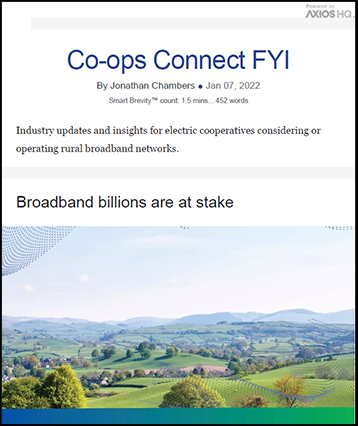Broadband billions are at stake
January 7, 2022
The 2021 Infrastructure Act will send two-thirds of its $65 billion in broadband funds to state governments, a seismic shift away from federal funding decisions on rural broadband.
- Why it matters: There is now enough funding to deliver fiberbroadband to every unserved/underserved rural household in the country, and electric cooperatives can build and operate fiber broadband networks more efficiently than others.
Industry updates and insights for electric cooperatives considering or operating rural broadband networks.
What we can expect:
- NTIA must, over the next six months, set the state allocations and requirements for states to apply for the funding.
- Yes, but: Those requirements may conflict with current state broadband plans, delaying states’ access to their funds and increasing network deployment costs.
In addition, Congress has appropriated other funds for broadband and smart grid:
- $14.2 billion for a new FCC Affordable Connectivity Program.
- $2 billion for ReConnect.
- $2 billion for broadband in tribal lands.
- $1 billion for “middle mile” infrastructure.
- $2.75 billion for state and federal digital equity programs.
- $10 billion for electric grid resilience and reliability.
Potential roadblocks remain:
- Telephone and Cable incumbents, after years of government protection and financial support, will claim that funding provided to competitors will be used to “overbuild” their networks.
- Providers of inferior technology, under the false flag of “technological neutrality,” will argue for short-term fixes at the expense of rural America’s long-term vitality.
- Extraneous social policy issues – including artificial “prevailing wage” requirements, net neutrality and open access obligations – will seep into funding programs, increasing broadband costs and decreasing funding effectiveness.
Co-ops can influence policy
Target three significant areas of focus for rural broadband:
1) Mapping unserved/underserved areas should be wrapped up. Mapping is a source of interminable delay. Neither new, final FCC maps, nor state programs that rely on those maps, will be ready until 2023.
Should you build in an unserved area now, you likely will not be eligible for funding later.Either NTIA or states could help by deciding that areas eligible for funding are those that were unserved on November 15, 2021, the date the Infrastructure Act was signed into law.
2) Public funds should be used for long-term infrastructure. Reimbursement for broadband construction should be limited to long-term assets, those with a 30+ year useful life.
3) Public funds for broadband infrastructure should be used for broadband infrastructure, not social policy. Leave the Washington social policy debates for another time.
Final Thoughts
The federal and state governments have spent nearly $100 billion on rural broadband over the past decade.
- Yes, but: We still have the same number of unserved households.
The bottom line: The right policy matters more than the amount of money.
